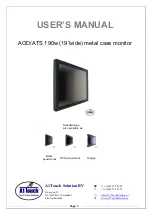
Section
1 -608
GENERAL INFORMATION
I NTR O DUCTI O N
O PE RATO R S M A N UAL
The Operators Manual contains information necessary
to effectively operate the
608
Monitor and is divided
into three sections: Section 1 provides a basic
description of the
608
with instrument specifications
and accessories. Section 2 contains operating
information for the instrument. Information on the
options available for the
608
Monitor is located in
section
3
of the manual.
I N ST R U CTI O N MANUAL
The Instruction Manual provides both operating and
servicing information for the
608
Monitor. The
Instruction Manual is divided into ten sections.
O perating information is covered in the first two
sections; servicing information for use by qualified
service personn el is contained in the remaining eight
sections of the manual. Schematic diagrams are
located at the rear of the manual and can be unfolded
for reference while reading other parts of the manual.
The reference designators and symbols used on the
schematics are defined on the first page of the
D iagrams and Circuit Board Illustrations section. All
abbreviations used in this manual, with the exception
of the parts lists and schematic diagrams, comply with
the American National Institute
V1.1-1972
publication.
The parts lists are computer printouts and use
computer-supplied abbreviations. Information on the
options available for the
608
Monitor is located in
section
9
of the Instruction Manual.
I N STRUM E N T D ESCR I PT I O N
The
608
Monitor is a compact, solid-state instrument
with excellent resolution, providing accurate displays
of information from the
X,
V,
and
Z
signal inputs.
@
WARNING
High voltage is present inside the
instrument. To avoid electric shock,
operating personnel must not remove
protective instrument covers. Component
replacement and internal adjustments must
be made by qualified service personnel
only.
Vertical and horizontal signals to be displayed on the
crt are supplied to the Deflection Amplifiers through
the appropriate
X
and
V
INPUT connectors. The
Deflection Amplifiers process the input signals and
provide push-pull outputs to drive the deflection plates
of the crt. B oth Deflection Amplifiers contain pOSition
and gain controls.
The Z-Axis Amplifier controls the display intensity by
providing a voitage to drive the crt controi grid. input
signals are applied to the Z INPUT connector.
The Dynamic Focus circuit provides focus correction
for the display when the crt beam is deflected from
the crt cent�r; Thus, by varying the voltage to the crt
focus element, the Dynamic Focus circuit compensates
for geometric defocusing.
The High-Voltage and Low-Voltage Power Supplies
provide all the voltages necessary for operation of this
instrument.
1-1












































